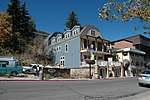Eugene Streeter House
Houses completed in 1885National Register of Historic Places in Summit County, UtahUtah Registered Historic Place stubs
The Eugene Streeter House, at 335 Ontario Ave. in Park City, Utah, was built around 1885. It was listed on the National Register of Historic Places in 1984.It is a one-story frame "T/L cottage" with a gable roof, with a porch on the west side of the stem-wing. A rear shed extension was added before 1889.It was vacant and in deteriorated condition in 1984, with no doors or windows.
Excerpt from the Wikipedia article Eugene Streeter House (License: CC BY-SA 3.0, Authors).Eugene Streeter House
McHenry Street,
Geographical coordinates (GPS) Address Nearby Places Show on map
Geographical coordinates (GPS)
| Latitude | Longitude |
|---|---|
| N 40.643055555556 ° | E -111.4925 ° |
Address
McHenry Street 176
84060
Utah, United States
Open on Google Maps








